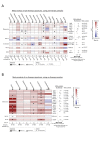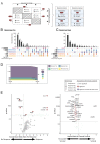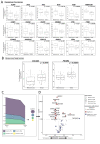Quantifying the impact of immunotherapy on RNA dynamics in cancer
- PMID: 37914385
- PMCID: PMC10626770
- DOI: 10.1136/jitc-2023-007870
Quantifying the impact of immunotherapy on RNA dynamics in cancer
Abstract
Background: Checkpoint inhibitor (CPI) immunotherapies have provided durable clinical responses across a range of solid tumor types for some patients with cancer. Nonetheless, response rates to CPI vary greatly between cancer types. Resolving intratumor transcriptomic changes induced by CPI may improve our understanding of the mechanisms of sensitivity and resistance.
Methods: We assembled a cohort of longitudinal pre-therapy and on-therapy samples from 174 patients treated with CPI across six cancer types by leveraging transcriptomic sequencing data from five studies.
Results: Meta-analyses of published RNA markers revealed an on-therapy pattern of immune reinvigoration in patients with breast cancer, which was not discernible pre-therapy, providing biological insight into the impact of CPI on the breast cancer immune microenvironment. We identified 98 breast cancer-specific correlates of CPI response, including 13 genes which are known IO targets, such as toll-like receptors TLR1, TLR4, and TLR8, that could hold potential as combination targets for patients with breast cancer receiving CPI treatment. Furthermore, we demonstrate that a subset of response genes identified in breast cancer are already highly expressed pre-therapy in melanoma, and additionally we establish divergent RNA dynamics between breast cancer and melanoma following CPI treatment, which may suggest distinct immune microenvironments between the two cancer types.
Conclusions: Overall, delineating longitudinal RNA dynamics following CPI therapy sheds light on the mechanisms underlying diverging response trajectories, and identifies putative targets for combination therapy.
Keywords: gene expression profiling; immune checkpoint inhibitors; immunotherapy; translational medical research.
© Author(s) (or their employer(s)) 2023. Re-use permitted under CC BY-NC. No commercial re-use. See rights and permissions. Published by BMJ.
Conflict of interest statement
Competing interests: DB reports personal fees from NanoString and AstraZeneca, and has a patent PCT/GB2020/050221 issued on methods for cancer prognostication. KD provides consultancy services to Achilles Therapeutics. YW consults for PersonGen Biotherapeutics and E15 VC. MK received research funding paid to the institute from BMS, Roche, AstraZeneca, has advisory roles compensated to the institute for: Daiichi Sankyo, BMS, MSD, Novartis, Roche outside the submitted work, and speakers’ fee paid to the institute from: Roche, BMS and Gilead. CS acknowledges grant support from AstraZeneca, Boehringer-Ingelheim, Bristol Myers Squibb, Pfizer, Roche-Ventana, Invitae (previously Archer Dx Inc—collaboration in minimal residual disease sequencing technologies) and Ono Pharmaceutical. CS is an AstraZeneca Advisory Board member and chief investigator for the AZ MeRmaiD 1 and 2 clinical trials, and is also co-chief investigator of the NHS Galleri trial, funded by GRAIL, and a paid member of GRAIL’s Scientific Advisory Board. He receives consultant fees from Achilles Therapeutics (where he is also a Scientific Advisory Board member), Bicycle Therapeutics (where he is also a Scientific Advisory Board member), Genentech, Medicxi, Roche Innovation Centre—Shanghai, Metabomed (until July 2022) and the Sarah Cannon Research Institute, had stock options in Apogen Biotechnologies and GRAIL until June 2021, currently has stock options in Epic Bioscience and Bicycle Therapeutics, and has stock options in and is co-founder of Achilles Therapeutics. CS is an inventor on a European patent application relating to assay technology to detect tumor recurrence (PCT/GB2017/053289); the patent has been licensed to commercial entities and under his terms of employment CS is due a revenue share of any revenue generated from such license(s). CS holds patents relating to targeting neoantigens (PCT/EP2016/059401), identifying clinical response to immune checkpoint blockade (PCT/EP2016/071471), determining HLA loss of heterozygosity (PCT/GB2018/052004), predicting survival rates of patients with cancer (PCT/GB2020/050221), identifying patients whose cancer responds to treatment (PCT/GB2018/051912), detecting tumor mutations (PCT/US2017/28013), methods for lung cancer detection (US20190106751A1), and identifying insertion/deletion mutation targets (European and US, PCT/GB2018/051892), and is co-inventor to a patent application to determine methods and systems for tumor monitoring (PCT/EP2022/077987). CS is a named inventor on a provisional patent protection related to a ctDNA detection algorithm.
Figures




References
Publication types
MeSH terms
Grants and funding
LinkOut - more resources
Full Text Sources
Medical
Miscellaneous
